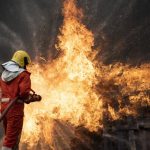
Flame Resistant Clothing vs Fire Retardant Clothing: What’s the Difference?
Originally posted on https://atlassafetysolutions.com/flame-resistant-clothing-vs-fire-retardant-clothing-whats-the-difference/
When it comes to fire safety, there is no room for doubt about whether your gear is keeping you safe. However, fire safety labels are confusing. They either say, “flame-resistant,” or “fire retardant.” So what exactly is the difference, and how do you know which type of material to choose?
Not to worry.
Here is a simple breakdown of flame-resistant clothing vs. fire retardant clothing. Understanding the difference will help you be certain you’ve got everything covered, literally.
Why the Difference Matters
It is important to understand why the difference matters.
Employees in many professions perform dangerous work where they are exposed to flammable conditions. Every job from fire-fighters, contractors, oil and gas technicians, and more.
Each role requires some kind of fire protection gear.
Even employees in an average chemical lab need fire protection. Wearing flame-resistant or fire retardant clothing protects employees. It also keeps employers safe from potential legal danger.
Flame-Resistant Clothing
First things first, flame-resistant clothing is considered “personal protective equipment“, or “PPE.” It is important to realize that while it will protect you from flames, it is still are not fire-proof.
If the wearer catches fire, flame-resistant clothing will prevent severe burns. It can save lives and stop life-threatening injuries.
How it works:
When flame-resistant clothing comes in contact with flames, it will catch fire. Yet, because of the materials used to make the clothing, flames extinguish almost immediately.
Once the clothing catches fire, it should not continue to burn.
The unique thing about flame-resistant clothing is the material. The fibers and threads are made with materials that prevent flames. The clothing is sewn together in a way that prevents flames from burning if exposed to fire.
Flame-resistant clothing self-extinguishes quickly.
Cost:
Flame-resistant clothing is more expensive. This is because it is specially made with unique materials. The cost varies depending on the type of clothing you need.
Different PPE will cost more than others. You’ll have to consider buying base layers, jackets, gloves, and more. Knowing what your employees do every day will help in your decisions.
It’s worth investing in flame-resistant PPE if you work in a field where you are often exposed to open flames.
Care:
How you take care of flame-resistant clothing vs. fire retardant is also different. Flame-resistant clothing lasts longer than flame retardant clothing.
It also keeps it’s flame-resistance longer through many wash cycles.
Fire Retardant Clothing
Fire retardant clothing is another form of PPE. It works similarly to flame-resistant clothing by stopping burning as soon as it starts. Fire retardant clothes are a great option for protecting you and your employees.
It’s important to know that fire retardant clothing is made differently from flame-resistant clothing. Fire retardant items are not naturally flame-resistant.
They must be treated chemically to become fire retardant.
Unlike flame-resistant clothing, fire retardant clothing is made from average clothing materials. It’s sewn together in a typical way. The special chemicals added to the clothes are what allow them to protect you from burns.
Cost:
Because fire retardant clothing is made from a wider range of materials, and then treated to become flame-resistant, it is slightly less expensive than naturally flame-resistant materials.
Usually, it works as well, as flame-resistant. If you are buying in bulk or looking to save, fire retardant clothing is a good option.
Care:
The care for fire retardant clothing is tricker than the care of flame-resistant clothing.
This is because, with each wash of fire retardant clothing, the fire retardant chemicals are weakened and become less effective.
If you choose the less-expensive fire retardant clothing, be aware that proper understanding of care for this clothing is important to keep it in good working condition as long as possible.
Be sure to read labels carefully and follow care directions.
This is an important factor in helping you decide whether flame-resistant or fire retardant clothing is right for you as well. It’s important to consider how often you will wear the clothing, and how dirty they will get each time. This will affect the number of times you need to wash them.
If you will be wearing your fire-resistant clothing on a daily basis and sweating a lot, it may be worth investing in naturally fire-resistant so your clothes can withstand more washes while still retaining their fire-resistant nature.
Flame-Resistant Clothing vs. Fire Retardant Clothing: How to Choose
At the end of the day, many consider fire-resistant clothing as the safer bet because of the difference in how it is made. Still, your choice of fire-protective clothing will depend on several different factors:
- Your company’s budget
- How much fire danger is involved in your work
- How often you or employees deal with flames or flammable substances
- The amount of clothing needed to keep employees totally safe
- Other PPE requirements
- How much gear and other materials employees will wear with their fire-safety clothing
Knowing what your work environment is like will help you make the best choice. Both clothing styles have pros and cons. If you’re looking to save money, and flammable substances aren’t common at your place of work, flame retardant gear is a quality choice.
Get Help Making the Safest Choice
If you’re still unsure whether to buy flame-resistant clothing vs. fire retardant clothing, seek consulting help. Safety professionals can help you understand the government’s requirements for PPE.
You can also find help with other safety services. Everything from mask fittings, equipment repair, inspections, meter testing, and training are available.
There’s no need to worry about safety or wonder if you’re ready to handle unfortunate accidents. Preparation is power.
For answers to your safety questions or help with any of these services listed, (and many more), contact us today or review our safety services page.
